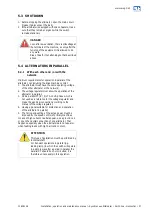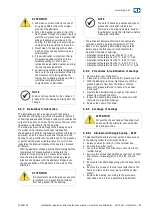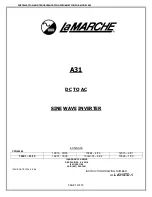
36 l
Installation, operation and maintenance manual – Synchronous Alternator – AG10 line - Horizontal 12638144
5
COMMISSIONING
The alternator leaves the factory with a shaft or disc lock device on the shaft or disc for better safety in transportation.
Before putting it into operation, this lock must be removed.
The connection of the terminals comply with the nominal characteristics of the alternator plate.
To perform the adjustment of voltage and frequency, refer to the manual of the voltage regulator.
5.1
PRELIMINARY TEST
Before being given the initial start or after a long time
without operation, check:
1.
If the alternator is clean and the packaging materials
and protective elements were removed from;
2.
If the connection parts of the coupling are in perfect
condition and well-greased and tightened where
necessary;
3.
If the alternator is aligned;
4.
If the bearings are properly lubricated and in working
condition;
5.
If the cables of the thermal protectors, grounding and
of the heaters are connected. (if any);
6.
If the insulation resistance of the windings has the
prescribed value;
7.
If all objects such as tools, measuring instruments
and alignment devices were removed from the
alternator work area;
8.
If the alternator is well fixed;
9.
If electrical connections are in accordance with the
wiring diagram alternator;
10.
If the voltage regulator is properly connected and
adjusted according to its installation manual;
11.
If the conductors of the network are properly
connected to the main terminals as to prevent a short
circuit or their release;
12.
If the alternator is properly grounded;
13.
Manually rotate the set in order to ascertain if there is
no interference in the air-gap. Driven the alternator at
no load, it must rotate slightly and without strange
noises;
14.
If the air inlets and outlets are clear;
15.
If the measure "G" is in accordance with the
specification for the diesel engine to be coupled (for
single bearing alternators).
5.2
INITIAL OPERATION
In addition to following, the safety instructions given in
chapter 2.2 of this manual, to put the alternator into
operation for the first time the following procedure must
be adopted:
1.
Make sure that the alternator terminals are
disconnected from the load by removing the fuse
panel or circuit breaker or placement of the key in
position "off";
2.
Turn off the space heaters of the alternator (if any),
before putting it into operation;
3.
disconnect the voltage regulator (removing the fuse in
series with the auxiliary coil);
ATTENTION
The U / F function of the regulator is factory
set, but as additional, security we recommend
disconnecting the regulator.
4.
Rotate the set and check for weird noises;
5.
Activate the alternator to rated speed and check
noise, vibration and check all protective devices;
After following the procedures described above and
resolved any problems that occurred (see item 8) turn off
the set;
6.
With the alternator completely stopped, connect the
voltage regulator (replace fuse), activate the set and
make the necessary adjustments. The voltage
regulator manual describes the procedures for
available adjustments (stability, voltage, U/F);
7.
Close the main circuit breaker and apply load and
monitor current of the alternator making sure that it is
within the specified;
8.
Check the vibration and temperature monitoring of
the set and measuring instruments (current, voltage
and frequency). If there is significant variation in the
vibration of the assembly between the initial condition
and after thermal stability, it is necessary to reassess
the alignment / leveling of the set.
ATTENTION
All measuring instruments and control should
be under constant observation so that any
changes in operation can be detected and
remedied.
















































